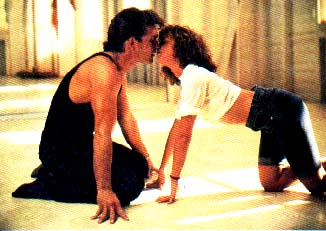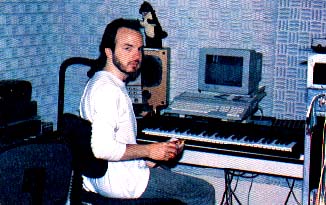Making Tracks With MIDI
Dirty Dancing On The ST
by Mard Naman
One of the most memorable scenes in the film Dirty Dancingis also one of the most mesmerizing. On a hot summer night, Baby, a rich and naive guest at a mountain resort, wanders through the door of the employees' recreation hall and is stopped short. There before her is a room full of "dirty" dancers. It's the most sexually explicit dancing she's ever witnessed and she is both embarrassed and captivated by it. But by the end of the scene, Baby has joined in herself.
The key to the success of this scene is the music. The song that's playing is the classic Do You Love Me, recorded in 1962 by the Contours. No one back then could have possibly imagined it would be reincarnated with such success 25 years later.
The Dirty Dancing film and soundtrack were the sleeper hits of 1987. Even as late as the spring of 1988, the Dirty Dancing soundtrack continued to bump off its competition, including new releases by Bruce Springsteen and Michael Jackson. At one point, the original soundtrack album and the followup, More Dirty Dancing, were first and third on Billboard's Top 100. Do You Love Me? appears on More Dirty Dancing and sold over 300,000 copies as a single.
 |
| Patrick Swayze and Jennifer Grey in a scene from Dirty Dancing. Photo supplied by Vestron Pictures. |
ST to the Rescue
The Atari ST's MIDI capabilities played a pivotal role in giving Do You Love Me? new life in the 1980s. When the producers wanted to release the song as an extended-play dance single, they were faced with a vexing problem: How do you stretch a 2 1/2 minute song to six minutes? Berry Gordy, Motown founder and the song's author, turned to record producer and remix-wiz Brian Tankersley for the answer.
"This was originally a three-track recording," says Tankersley. "They [the producers of the film] wanted six minutes, but a three-track is difficult to stretch. Track One has everything. Track Two has guitars, hand claps and vocals. Track Three is the lead vocal. [Since] the drums, bass, voice, piano--everything--is on Track One, you can't do edits."
Enter the ST. "Using my Atari ST and Hybrid Arts' SMPTE Track, I made a tempo map of the song. The Contours were definitely rushing and dragging, no doubt about it. They had about a 6-7 beat per minute variation over the course of the tune. It was "Hi-ho Silver away!" for the chorus and slam on the brakes for the verse!" laughs Tankersley. (Editor's Note: Jamie Krutz reviewed SMPTE Track in the October 1988 issue of START.)
But the ST was up to the task of mapping these extreme tempo changes. "I got it so tight that it would quantize," says Tankersley, "and just took off from there." He redid the drums, bass, keyboards and percussion. "Using samplers, triggering drums, I tried to stay true to the original sound to a degree, but have it fit more into an '80s dance groove at the same time"
Tankersley says his ST made the job possible. "If I was going to brag, I'd say I don't think anything but an ST with SMPTE Track would have done the job. I really don't. I was able to duplicate those tempo changes completely. I had 40 tempo changes in 2 1/2 minutes, and had to use fractional tempos (fractions of beats), some of them radical and some mild. Not once in the two days in the studio did the ST fail to nail it and lock exactly, perfectly, the first time every time, even calculating all those tempo changes."
Adds Tankersley with genuine admiration for his ST, "Any other system would have taken a lot more time to lock up and would have done it a lot less accurately. I've never seen anything but the ST with SMPTE that always locks when you hit Play on the tape deck. You hit Play, it locks and it's tight."
No Gimmicks Please
Tankersley could have sampled the vocals and flown them in, but he chose not to do that. "Manipulating the vocals with samplers can get a little gimmicky," he explained. "Besides, I felt the Contours were singing better than people sing today--those vocal performances were done when people had to sing great all the way through the song. I didn't want to mess with the vocals and get gimmicky. I didn't want to be known as the guy who screwed up a great song."
No one would accuse him of that. Rather, he found the best of both worlds: the great vocals came straight from the 1960s, while MIDI brought the instrumental sounds into the 1980s, all the while remaining true to the original feel of the song.
Tankersley specializes in LP production of dance and groove-oriented pop music. He has worked with artists like Motown greats Smokey Robinson and The Temptations. "I do a lot of R & B, a lot of groove-oriented stuff where timing is important; timing is everything," says Tankersley. "Only the ST nails it every time"
Tankersley has a 24-track facility at his home. "Basically, my 1040 ST forms the heart of the system," he says. "I'm a total believer. My ST using Hybrid Arts software is bug-proof and incredibly accurate, timing-wise. What more could you ask for?"
Tankersley wouldn't use another computer. "I've checked everything-- Amiga, IBM, Mac--and I haven't even considered switching. Price notwithstanding--and, of course, price is in the ST's favor--the ST is the best MIDI hardware. If there was something I thought was better, I'd buy it. Price wouldn't slow me down. I want the best, because I'm making my living using this machine."
 |
| Reworking the 1962 classic Do You Love Me! for the film Dirty Dancing, posed a unique challenge to Brian Tankersley and his ST. The question: "How do you stretch a 2 1/2 minute song to six minutes?" |
Tankersley has one ST at the moment, "but I'm just about to add a second because there are too many programs I want access to. Also, I'm running two different complementary sequencers, so I'll be bouncing back and forth via MIDI. I find with the 1040 and one megabyte I can utilize a 50-track sequencing program and GenPatch and have them both up on line at the same time."
As a recording engineer, Tankersley has seen his ST become more and more important in the studio. "Recently, I've been using the ST as a real-time replacement for tape machines. I'll hire someone to play keyboards, and they'll bring in their favorite MIDI controller--the DX-7, for example. I just hand them a cable to plug into the MIDI out. Then I engineer the session on the ST as though it were a tape machine. Orginally the ST was an addendum to the tape machine. Now the tape machine is an addendum to the ST."
Playing the Computer
Tankersley classifies himself as essentially a technically-oriented person, but as he started working with his ST, he found a lot of his latent creativity bubbling to the surface. "The ST has caused me to do a lot more songwriting," boasts Tankersley. Indeed, his first ST-written song, Higher, was released last fall.
"I'm one of that new breed of musician," says Tankersley. "I play the computer. With my sequencer I have enough equipment so that I can hear the whole rhythm section, the whole drums, bass, keyboards, overdubs and percussion all in real-time. It's inspirational. When I have an idea I might normally play on the piano, I play it on the sequencer and then I put a drum beat down and a bass line down. All of a sudden, I start making changes. It gets me going in different directions and its a real interactive process with a lot of user-friendly feedback.
"My primary instrument is electric bass. The problem is that as a bass player, I'm not a proficient keyboardist. But with the ST and a good sequencing package, my mind is the only limit. The ST is able to compensate for my playing deficiencies. We've gotten to be very good friends.
Marc Naman is a freelance writer who specializes in personality profiles. He is a frequent contributor to START.
PRODUCTS MENTIONED
SMPTE Track, $575. Hybrid Arts, Inc., 11920 West OIympic Boulevard, Los Angeles, CA 90064. (213) 826-3777. Computer BBS (213) 826-4288.